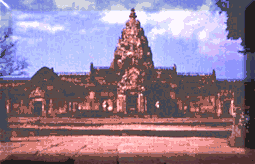
Prasat Kao Panom Rung is located on the top of the Mount Panom Rung near Tapek village, locality of Tapek, Nang Rong District, Burirum Province, in the northeast of Thailand. This area is near Thai-Cambodian border.
Kao Panom Rung was previously a valcano, apart of Panom Dong Rek Mountain. It is the biggest and the highest mount, with 383 metres above sea level, 4 km wide from east to west, 6 km long from north to south.
Prasat Kao Panom Rung is a Hindu temple. The first brick pagoda was built in the middle of the 15th century of the Buddhist era. It is believed that it was restored by King Rachentara voraman II (year 1487-1511of Buddhist era) and King Chai Voraman IV (year 1511-1544 of Buddhist era), Cambodian kings whom had been patron to Siva Nigaya Hindu (Hindu with Siva ideology). This ideology had been successful through the 14th to 18th century of Buddhist era until King Chai voraman VII changed it to be Mahayana Buddhist.
Structures at Prasat Kao Panom Rung, order categorized from bottom to top of the mount, are outer balcony structures, outer balcony, curvy inner balcony, and the part built with sandstone and laterite stone that consists of 6 buildings. These structures are described below.
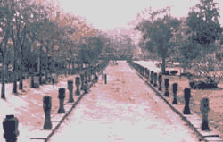
1. Front stair; Start from the east hillside, built with laterite stone. There are 3 levels of stairs. The end patio is like a cross shape.
2. The royal pavilion;A hall built with sandstone and laterite stone. It is located in the northeast of the crossed patio. It is a king's changing place, and also the place for royal procession before proceeding to the ceremony took place on the top of the mount.
3. Royal walkway; A walkway continued from the crossed patio's stairs, laid by laterite stone with sandstone kerb. The kerb's top was shaped like a lotus. There are 2 rows of standing sandstone columns.
4. Nakaraj bridge; built with sandstone. The bridge's rails are carved to be Naka's body with 5 heads. This bridge is the position that links the walkway and stairs to, the first sector, Prasat and two ponds and, the second sector, the area inside the curvy balcony. The third sector links the gate and the main pagoda.
5. Stairs to Prasat; built with sandstone. It links the first section of Nakaraj bridge and the higher flat area on the Mount.
6. The way to Prasat; They are two stairs built beside the main stairs to the 4th level of Prasat.
7. Outer balcony. This one is a slightly elevated walkway, laid by laterite stone and linked to both sides of the way to Prasat.
8. The gate and the inner curvy balcony; built with sandstone and laterite stone. Long rooms are connected in rectangular style. Walls were built from floor to roof so it definitely separates each room. Inside the rectangular area of the inner curvy balcony is the most important part. It can be called a set of inner Pratsat. There are 6 buildings.
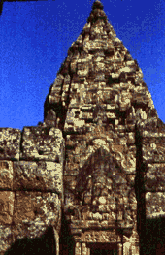
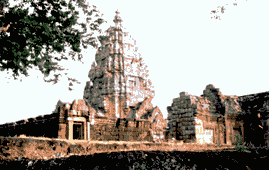
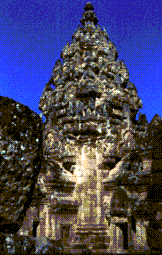
1. The main pagoda; built with brick and sandstone, nearly located at the center of the area. Its shape is a squared with contracted angles. The size is 8.20x8.20 m, 27 m high. There are 3 doubled porticos at the north, south and west. It was, presumably, built during 16th -17th century of the Buddhist era.
2. Little pagoda; built with sandstone and laterite, located at the southwest of the main pagoda. Its shape is squared with contracted angles. The size is 6x6 m, 5 m high. It was built, approximately, 16th century of the Buddhist era.
3. Two brick pagoda ;built with brick and sandstaone, nearly lacated at the northwest of the main pagoda. One brick pagoda faces east, the other faces south. It was built during 15th century of Buddhist era.
4. Shrines; built with laterite stone, rectangular, only one entrance. The roof looks like a boat's roof. There are 2 shrines. One is in the southwest, the other is in the northeast, of the main pagoda. Approximately built in 18th century of the Buddhist era.
Prasat Kao Panom Rung is a construction that represents faith, Holiness and it is the centre of exquisiteness in Arts and Architectures. The prominence is the location of Prasat. When you start walking from the hillside and take your steps up the mount, it creates the feeling as if you walking up to heaven.
When you reach the top of the mount, where Prasat locates. It is the highest position, so you can see all area surrounding the mount. You would feel it is like the peak of the Universe. As entering the inner curvy balcony, exquisitely carved stones are immages that tell us stories. They are both beautiful and woderful, also full of knowledge. Here are some examples.
1. The immage of Vishnu, reclining on lintel, at the eastern face of antechamber, which is above the entrance gate to the main pagoda. This Vishnu's immage has been famous and worldwide well known.That is Narai Buntom Sindhu,meaning Narai is asleep, above the potentate of Naka in the great ocean.
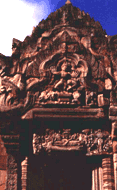
The Narai Bantom Sindhu had been missing from Prasat Kao Panom rung for a long time and the investigation had also been continuously in progress. It was later found that it was in USA. There were many campaigns organized by Thai people and technical expertise calling for the return of this image to Thailand. The campaigns were finally successful and the image is now at where it was first placed.
The Narai Buntom Sindhu is involved with Brahma, the creation of the world, the asleep Narai means a world's time of Kullapa (a duration of time ending in the destruction of the world by fire). Whenever Narai is asleep, the universe would be destroyed. One Kullapa lasts from the creation of the world to the destruction of the world.
2. The image of the trantic ceremony on southern half-pediment, antechamber, main sanctuary. This is a carved images of six persons (one is dilapidated) performing some kind of ceremony. One person (the dilapidated one) is sitting, bending legs, leaning backwards, and uses arms to keep the body stable. Two persons are sitting behind. Others three persons sit in the front. One is a standing woman, the other two are men. One man uses his left hand to grab the ankle of the person who is sitting. His right hand holds a cylinder. The second man interestedly looks at the others.
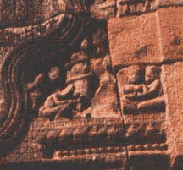
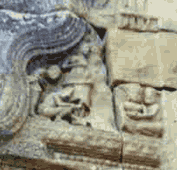
If possible, the carved ceremony could be a representation of the trantic ceremony of the virgin woman proceeded by a clergy. This ceremony is a tantra Hindu.
"Two stories mentioned above are more than enough to attract tourists, both Thai and foreign, to come and admire Prasat Kao Panom Rung."
![]() Travelling to Prasat Kao Panom rung can
be made via two main routes.First, take the main road
via Nang Rong district, Burirum province. There is a by road on the
south which will lead you to Prasat.Second, take the
road from Pra Kon Chai district
Burirum province, on the
east. There is also a road to Prasat.
Travelling to Prasat Kao Panom rung can
be made via two main routes.First, take the main road
via Nang Rong district, Burirum province. There is a by road on the
south which will lead you to Prasat.Second, take the
road from Pra Kon Chai district
Burirum province, on the
east. There is also a road to Prasat.
Translator : Aketawan Manowongsa
2 September 2000





